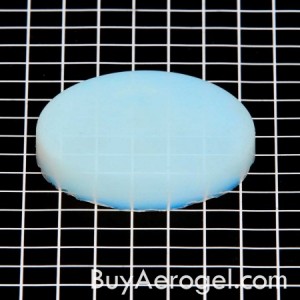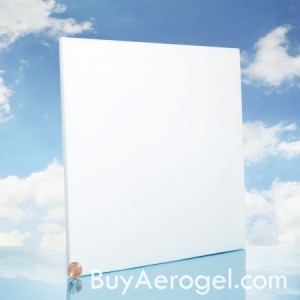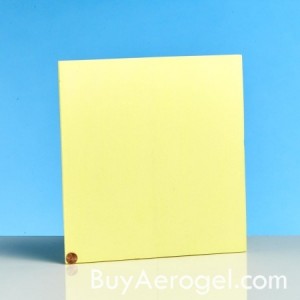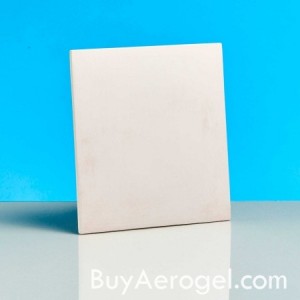Airloy® Products
Overview
Airloy Ultramaterials are available in different compositions, densities, and form factors. Different Airloy compositions offer different materials properties such as operating temperature range, flammability properties, water resistance, light transmissiveness, strength and stiffness vs. density, and chemical stability. Related compositions are grouped by series. Each series may contain several different formulations optimized for different applications.
Airloy materials are designated by a formulation number and density class. Airloy materials of different compositions are offered in different density classes to help end users select materials that optimize weight, structural properties (which improve as density increases), thermal conductivity (which decreases as density decreases), and other materials properties for their application.
Density Classes
Materials properties of Airloy Ultramaterials vary with density. Properties such as mechanical strength and stiffness increase with increasing density, while properties such as thermal conductivity tend to decrease with decreasing density. As a result, Airloy Ultramaterials are sold by density class to provide products that optimize materials properties differently.
Density classes are described in the following table.
| Density Class | Bulk Density | Qualitative Description |
| XL | 0.08 g/cc ± 0.02 |
|
| L | 0.10 g/cc ± 0.02 |
|
| M | 0.20 g/cc ± 0.05 |
|
| MH | 0.30 g/cc ± 0.05 |
|
| H | 0.40 g/cc ± 0.05 |
|
| XH | 0.55 g/cc ± 0.05 |
|
Not all materials are offered in all density classes due to limitations in the chemistry and feasibility of production of different formulations.
Part Number Format
Airloy materials are denoted by the following part number format:
ABC-D F
| Part Number Component |
Significance | Options |
| A | Application |
|
| B | Composition series |
|
| C | Specific formulation within composition series |
|
| D | Density class, see density class table for more information |
|
| F | Special features |
|
Airloy Product Series
Airloy X50 Series
- Composition: Polymer-crosslinked silica aerogel
- Target Utility: Light-transmissive applications
- Features: Transparent materials that are 4x lighter than plastics, more insulating than Styrofoam or still air, and mechanically durable. Look like classic aerogel for an intriguing aesthetic effect and provide insulating properties but provide image-preserving transparent clarity for daylighting applications. Available in 0.3 g/cc with operating temperatures up to 80°C.
- Available Products: Airloy X56-MH
- Resources: Materials properties

Airloy X100 Series
- Composition: Polyurea aerogel
- Target Utility: Lightweight plastics replacements
- Features: Excellent mechanical strength and stiffness at low densities. Dramatically superior soundproofing properties over other soundproofing materials over high frequencies. Thermal insulating properties comparable or superior to expanded polystyrene and polyurethane foams. Plastic-like feel, semi-flexible at thicknesses less than 3 mm, easy to machine, thermoformable. Available in 0.1, 0.2, and 0.4 g/cc. Other densities available as custom solutions. Operating temperatures up to 80°C.
- Available Products: Airloy X103-L, Airloy X103-M, Airloy X103-H, Airloy X103-XH
- Resources: Materials properties, introduction video, video

Airloy X110 Series
- Composition: Polyimide aerogel
- Target Utility: High-temperature lightweight plastics replacements
- Features: Operating temperatures up to 400°C. Non-flammable. Great mechanical strength and stiffness at low densities. Thermal insulating properties superior to traditional insulation. Rigid material. Available in 0.2 and 0.4 g/cc. Other densities available as custom solutions.
- Available Products: Airloy X114-M, Airloy X114-H, Airloy X116-XL, Airloy X116-L, Airloy X117-L
- Resources: Materials properties, Airloy X114-H aviation burn certification video, Airloy X116 introductory video

Airloy X130 Series
- Composition: Polyurethane aerogel
- Target Utility: Medium-temperature lightweight plastics replacements
- Features: Excellent mechanical strength and stiffness while still 3-4x lighter than plastics. Dramatically superior soundproofing properties over other soundproofing materials over high frequencies. Thermal insulating properties comparable to expanded polystyrene and polyurethane foams. Easy to machine, thermoformable. Available in 0.3 and 0.4 g/cc. Other densities available as custom solutions. Operating temperatures up to 130°C.
- Available Products: Airloy X134-MH
- Resources: Materials properties

Specialty Airloy Formulations
Specialty Airloy formulation classes available as custom solutions include:
- Airloy X60 Series: Polymer-crosslinked vanadia aerogel, for ballistics applications
- Airloy X120 Series: Polyamide aerogel, for high-temperature and high-stiffness lightweight plastics replacements that do not trap heat
- Airloy X140 Series: Polybenzoxazine aerogel, for low-cost high-temperature/high-strength applications
- Airloy X400 Series: Strong carbon aerogels, for structural electrodes—pyrolyzed versions of aromatic polymer Airloys, for example, Airloy X414 is a high-surface-area electrically-conductive carbonized version of Airloy X114
Materials Properties Ranges by Series
Airloys offer the right optimization of materials properties for your application. Below is a summary of the materials properties spanned by different Airloy series.
For information about specific products in these series, view materials properties for specific Airloy products or view our Airloy product selection guide for more information.
| Series | Density [g/cc] | Young’s Modulus [MPa] | Yield Strength [MPa] | Thermal Conductivity [W/m-K] | Operating Temp [°C] |
| X50 | 0.1 – 0.55 | 1 – 235 | 0.03 – 6 | 0.024 – 0.055 | 130 |
| X60 | 0.4 – 0.65 | 220 – 620 | 5 – 16 | 0.024 – 0.055 | 130 |
| X100 | 0.1 – 0.55 | 8 – 360 | 0.4 – 12 | 0.024 – 0.055 | 80 |
| X110 | 0.1 – 0.55 | 5 – 220 | 0.2 – 11 | 0.020 – 0.044 | 300 |
| X120 | 0.1 – 0.35 | 125 – 215 | 0.6 – 5 | 0.025 – 0.04 | 250 |
| X130 | 0.16 – 0.55 | 1 – 400 | 0.04 – 6 | 0.030 – 0.060 | 130 |
Shapes, Sizes, and Form Factors
Airloy Ultramaterials come in a wide variety of shapes, sizes, and form factors to accommodate different applications.
3D parts made from Airloys are typically machined from blanks or molded to specification. A good material for comparison for how shape is imparted onto Airloys is PTFE plastic like Teflon, which is typically either machined by the user or molded to spec by the manufacturer. Some Airloys, particularly Airloy X103, can be thermoformed to impart curvature and other complex features. Airloys are not injection molded or additively manufactured at this time.
Thanks to our patent-pending drying technologies, Airloy Ultramaterials can be produced as 3D shapes, parts, and thin films in arbitrary lengths and widths with practical thicknesses up to 2 cm. Although theoretically parts of any thickness can be produced, thicker parts take longer to produce than thinner parts and so we generally limit part thicknesses to 2 cm maximum. However, thanks to the polymer nature and high-definition pore structure of Airloy Ultramaterials and our company’s patent-pending layered aerogel composites technology, we can produce Airloy parts of arbitrary thicknesses by laminating plates together to make large, machinable 3D blanks.
Current form factors produced by our company and available for purchase on demand through BuyAerogel.com on a product-by-product basis include:
| Form Factor |
Dimensions | Availability |
| Coupons/tiles |
|
On demand through BuyAerogel.com |
| Panels |
|
On demand through BuyAerogel.com |
| Discs |
|
On demand through BuyAerogel.com |
| Large panels |
|
Custom solutions |
| Very large laminated blanks |
|
Custom solutions |
| Very large non-laminated panels |
|
Custom solutions |
| Continuous volume 3D shapes and parts |
|
Custom solutions |
| Continuous volume 3D shapes and parts not from laminated blanks |
|
Custom solutions |
| Thin films and flexible dust-free blankets |
|
Custom solutions |
| Particles |
|
Custom solutions |
Additional form factors, shapes, and applications integration options for Airloys nay be available through our custom solutions division.

